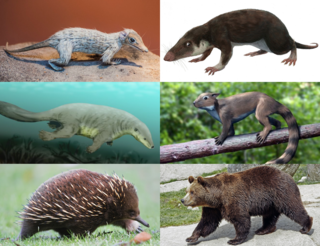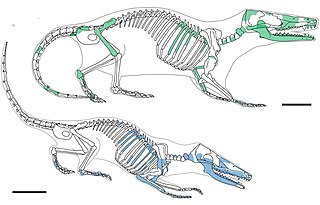Oligokyphus is an extinct genus of herbivorous tritylodontid cynodont known from the Late Triassic to Early Jurassic of Europe, Asia and North America.

Tritylodon is an extinct genus of tritylodonts, one of the most advanced group of cynodont therapsids. They lived in the Early Jurassic and possibly Late Triassic periods along with dinosaurs. They also shared many characteristics with mammals, and were once considered mammals because of overall skeleton construction. That was changed due to them retaining the vestigial amniote jawbones and a different skull structure. Tritylodons are now regarded as non-mammalian synapsids.

Mammaliaformes is a clade that contains the crown group mammals and their closest extinct relatives; the group radiated from earlier probainognathian cynodonts. It is defined as the clade originating from the most recent common ancestor of Morganucodonta and the crown group mammals; the latter is the clade originating with the most recent common ancestor of extant Monotremata, Marsupialia, and Placentalia. Besides Morganucodonta and the crown group mammals, Mammaliaformes includes Docodonta and Hadrocodium as well as the Triassic Tikitherium, the earliest known member of the group.
Tritylodontidae is an extinct family of small to medium-sized, highly specialized mammal-like cynodonts, with several mammalian traits including erect limbs, endothermy and details of the skeleton. They were the last-known family of the non-mammaliaform synapsids, persisting into the Early Cretaceous.
The Ulan Malgait Formation is a Late Jurassic geologic formation in Mongolia. Dinosaur remains are among the fossils that have been recovered from the formation, although as of 2004 none have yet been referred to a specific genus.

Yuanotherium minor is an extinct species of cynodonts which existed in China during the Late Jurassic epoch, described from the Shishugou Formation. It is the only species in the genus Yuanotherium.
Dinnebitodon is an extinct genus of advanced herbivorous cynodonts of the early Jurassic period. It has only been found in the Kayenta Formation in northeastern Arizona. It closely resembles the related genus Kayentatherium from the same formation. It is set apart by differences in the dentition, while resembling in most other respects.

Kayentatherium is an extinct genus of tritylodontid cynodonts that lived during the Early Jurassic. It is one of two tritylodonts from the Kayenta Formation of northern Arizona, United States.
Yunnanodon is an extinct genus of tritylodontid mammaliamorphs that lived in China during the Sinemurian stage of the Early Jurassic period. Its specific name brevirostre is Latin for "short-beaked".
Bienotheroides is an extinct genus of tritylodontid mammaliamorphs from the Jurassic of China and Mongolia. The genus contains five species, primarily known from cranial remains.
Lufengia is an extinct genus of tritylodonts from the Sinemurian Zhangjiawa Member of the Lufeng Formation of Yunnan, China. This taxon was recovered from the upper dark red beds in the Heiguopeng locality, along another Tritylodont, "Dianzhongia". This taxon represents the most abundant form in this layers, with up to 8 specimens. The holotype, MC V0009 is a fragmentary rostrum with upper post-canines and the posterior of the palatine. Another specimen was reported latter, CVEB12001, a partially crushed cranium. Thanks to this last find, it was proven that, IVPP V5072, named "Dianzhongia longirostrata" was just an older specimen of the same genus, indicating Lufengia skull sizes varied bewteeen 31 mm to 74.6 mm. The new specimen also showed Lufengia had continuous distomesial tooth replacement, like extant Heliophobius and Trichechus, indicating that maybe the postcanines were supernumerary and constantly replaced.
Polistodon is an extinct genus of tritylodonts from the Bajocian or Callovian of China. It contains one species, P. chuannanensis, which is known from a single skull from the Xiashaximiao Formation. According to one study, it may be a species of the genus Stereognathus.

Stereognathus is an extinct genus of tritylodontid cynodonts from the Middle Jurassic of the United Kingdom. There is a single named species: S. ooliticus, named after the Great Oolite deposits of England. A second species, S. hebridicus, was named after the Hebrides in Scotland, where it was found; it was synonymized with S. ooliticus in 2017.
Xenocretosuchus is an extinct genus of tritylodont therapsids from the Aptian Ilek Formation of Siberia, in the Russian Federation. The type species, X. sibiricus, is known only from dental elements, as is X. kolossovi, described from the Batylykh Formation in 2008. Some authors have treated these species as part of the genus Stereognathus, otherwise known from the Middle Jurassic of Britain, but this is rejected by other authors.
Kunminia is a genus of cynodont synapsids from the Early Jurassic (Sinemurian) Lufeng Formation of China.
Montirictus is an extinct genus of tritylodonts known from the Early Cretaceous Kuwajima Formation of Japan. It was among the latest surviving tritylodontids, and is closely related to the earlier Xenocretosuchus from mainland Asia, and the Jurassic Stereognathus from the UK. It may be a species of the genus Stereognathus, but resolution of its affinities conditions upon the discovery of additional material.

Borealestes is a genus of docodontan from the Middle Jurassic of Britain, first discovered on the Isle of Skye near the village of Elgol. It was the earliest mammaliaform from the Mesozoic found and named in Scotland. A second species and was later found in other Middle Jurassic sites in England, but is now shown to be a different genus. A new species, B. cuillinensis was named in 2021, also from Skye.
Shartegodon is an extinct genus of tritylodontid cynodont from late Jurassic Ulan Malgait Formation of Mongolia. The type species, Shartegodon altai, was named in 2017.
Fossiomanus is an extinct genus of tritylodontid mammaliamorphs from the Early Cretaceous of China. It includes one species, F. sinensis, which is known from a single nearly complete skeleton from the Aptian Jiufotang Formation. Features of its limbs and vertebrae indicate that Fossiomanus was adapted towards a fossorial lifestyle.
Michael Waldman is a British palaeontologist known for his work on fossil fish, mammals, and reptiles. He also discovered the globally important fossil site of Cladach a'Ghlinne, near Elgol on the Isle of Skye, Scotland. This site exposes the Kilmaluag Formation and provides a valuable record of Middle Jurassic ecosystems. During the 1970s he visited the site several times with fellow palaeontologist Robert Savage. The fossil turtle Eileanchelys waldmani was named after Michael in recognition of his notable contribution to palaeontology.











